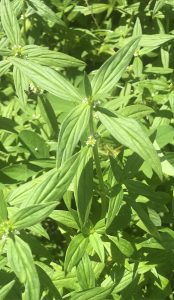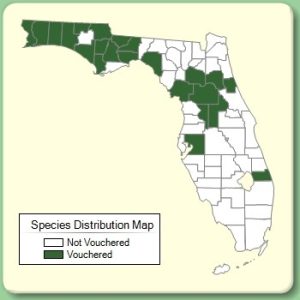Jay Capasso, UF/IFAS Columbia County. Marc Frank, University of Florida Herbarium. Paulette Tomlinson, UF/IFAS Columbia County.
The University of Florida Herbarium recently identified tropical girdlepod (Mitracarpus hirtus) for the first time from Columbia County. This weed has been identified in 23 other Florida counties including many of those in the panhandle and north/central peninsula. The plant is native to the West Indies, South America, Mexico, and Central America. It is introduced (non-native) in much of the world’s tropical and subtropical regions including the U.S. Gulf Coast states and Hawaii.
Tropical girdlepod is a member of the Rubiaceae plant family often referred to as the madder, coffee, or bedstraw family. In Florida, the plant grows as a summer annual–meaning it appears during the warmer months of the year and flowers, set seed, and dies within a single year. Typically growing 1-2 feet tall, tropical girdlepod often has multiple stems branching at or near ground level. These stems are predominantly green, 4-angled, and finely hairy, but basal stems can become woody, rounded, and hairless with age. The leaves are usually 1-2 inches long, oblong to elliptic in shape, and sessile (lacking a petiole or leaf stalk). The tiny white flowers are in clusters at both the branch tips and the leaf axils. Resembling false buttonweeds (genus Spermacoce), tropical girdlepod can be distinguished by examining the tiny capsular fruit under a microscope. In Mitracarpus, the capsules open along a transverse circular line, so that the top separates like a lid. In contrast, Spermacoce capsules open via a longitudinal slit along the inner surface, not separating into two parts. Consult your local extension agent, plant identification expert, or the University of Florida Herbarium for help distinguishing between these two species.
Control methods:
Currently there is no information available on how to control tropical girdlepod using herbicides under Florida conditions in crops, turf, pastures, or landscapes. Research elsewhere indicates the preemergence herbicides atrazine, diuron, oxadiazon or postemergence herbicides such as 2,4-D or glyphosate are effective (Husson et al. 2010). However, poor control was observed following a single application of glyphosate (24 oz of 53% glyphosate per acre rate) at one location in Columbia County.



References
Husson, O., H. Charpentier, F.-X. Chabaud, K. Naudin, Rakotondramanana L.S. (2010). Flore des jachères et adventices des cultures. Annexe 1 : les principales plantes de jachères et adventices des cultures à Madagascar. In : Manuel pratique du semis direct à Madagascar. Annexe 1 – Antananarivo : GSDM/CIRAD, 2010 : 64 p.
The commercial products listed are possible recommendations to help manage tropical girdlepod. This blog post is intended for educational purposes. It is not the intention of the authors to provide a complete list of product recommendations or endorse a particular product or brand.
 0
0
